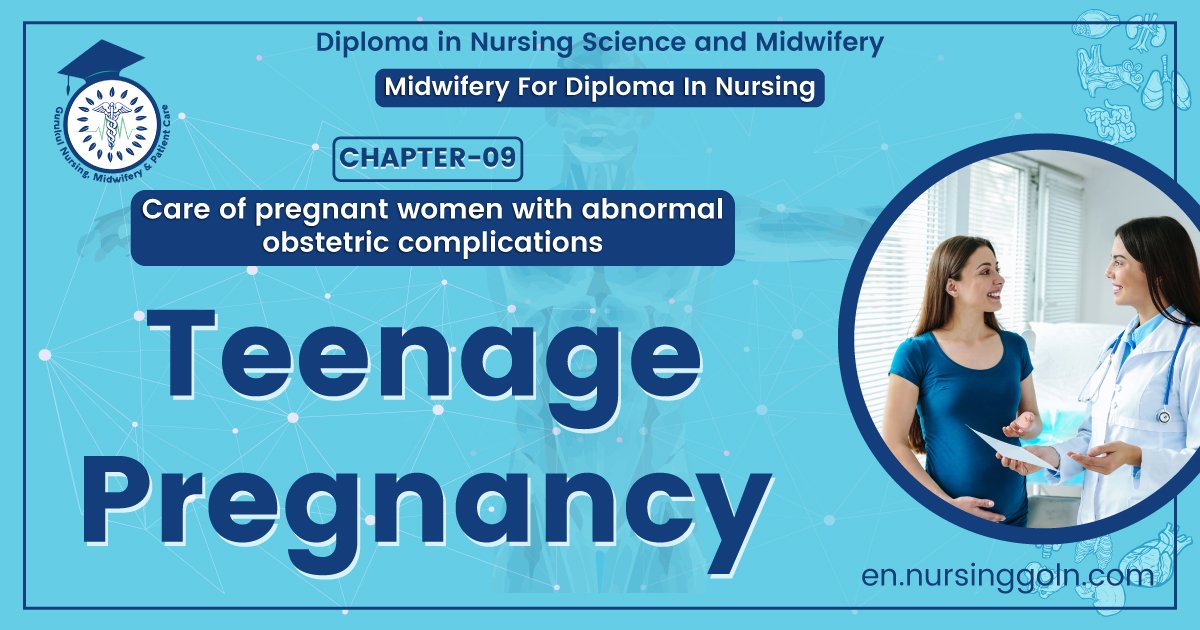Teenage Pregnancy – This course is designed to understand the care of pregnant women and newborn: antenatal, intra-natal and postnatal; breast feeding, family planning, newborn care and ethical issues, The aim of the course is to acquire knowledge and develop competencies regarding midwifery, complicated labour and newborn care including family planning.

Teenage Pregnancy
Definition of teenage pregnancy:
Teenage-pregnancy, also known as adolescent pregnancy, is pregnancy in females under the age of 20. A female can become pregnant from sexual intercourse after she has begun to ovulate, which can be before her first menstrual period (menarche) but usually occurs after the onset of her periods. In well-nourished females, menarche usually takes place around the age of 12 or 13.
Or
Teenage-pregnancy, also known as adolescent pregnancy, is pregnancy in females under the age
of 20. Teen pregnancies carry extra health risks to both the mother and the baby. Risks for the
baby include premature birth and a low birth weight.
Causes of teenage pregnancy:
1. Poverty.
2. Broken Home.
3. Separation of couple.
4. Single parent
5. Death of their parent(s).
6. Peer pressure or influence.
7. Lust-some teenagers get into sexual relationships because of lust.
8. Religious beliefs and practices.
9. Rape and sexual abuse.
10. Alcoholism and drug abuse.
11. Lack of knowledge or ignorance.
12. Environmental influence.
13. Pornography.

Risk of teenage pregnancy
There are a number of risk factors for teenage-pregnancy. They include:
- Family situations with regular conflict between members.
- Violence and sexual abuse in childhood.
- Unstable housing arrangements.
- Poor school performance.
- Poor school attendance.
- Low socioeconomic background
- Family history of teenage pregnancies.
- Low maternal education
- Low self-esteem.
- In a relationship with an older partner.
- Younger spe32 9.0
- Living in rural and remote areas.
Effects or Consequences of teenage pregnancy:
1. School dropout
2. Fatherless or bastard children
3. Street children
4. Arm robbery
5. Dependency burden
6. Death
7. Increase in economic hardship
8. Spread of diseases
9. Abortion
10. Family conflicts
Physical effects of teenage pregnancy:
According to the National Institutes of Health, there’s a higher risk of the following in teenage
pregnancy:
➤ preeclampsia
➤ anemia
➤ contracting STDs (sexually transmitted diseases)
➤ premature delivery
➤ delivering at low birth weight
➤ Pregnancy Induced Hypertension
➤ Pregnancy induced diabetes mellitus
➤ Obstructed labor
➤ Postpartum hemorrhage.

Prevention and Control of teenage pregnancy:
1. Sex education.
2. Charity and humanitarian aids.
3. Provision of studying materials.
4. Adult education.
5. Law enforcement.
6. Community outreach programmes.
7. Supporting efforts to prevent teen pregnancy by providing affordable family planning services.
8. Developing clinical guidance for safe and effective use of birth control.
9. Developing and evaluating programs in communities where teen births are highest.
10. Choose not to have sex.
11. Talk openly to parents or other trusted adults and ask how they can get birth control ifthey choose to be sexually active.
12. Talk with a health care provider to learn about the best types of birth control for them,
and use it and condoms correctly every time.
13. Find a nearby clinic that provides birth control.
Read More….
